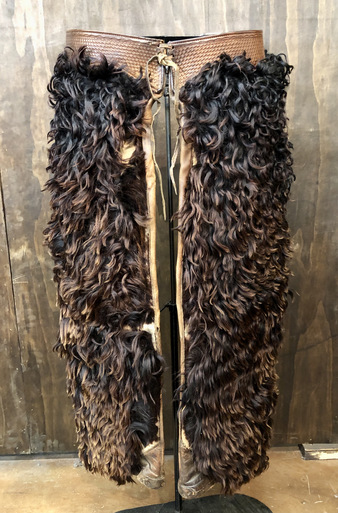Collector’s Corner - Chaps
Posted by Jim Olson on Nov 30th 2021
“Chaps” is an Americanized version of the Spanish word “Chaparreras” which loosely translates into, “for the brush.” This makes sense, as chaps are intended to protect the legs of horsemen from thorny vegetation, cactus, mesquite and various other hazards possibly encountered while riding the range. Chaps are also sometimes referred to as “leggings.” Like so many things “cowboy” in the Western United States, the wearing of chaps is something picked up originally from Mexican cowboys (vaqueros) during the 1800s.
Although many sources claim the origin of chaps to be Mexico, during the Spanish Colonial period, it is very possible the earliest known form of chaps actually comes from the South of Spain much earlier. Since we know the word chaps is short for chaparreras, and that this refers to leather coverings worn to protect a rider’s legs from the chaparral, we should look at the origin of the word chaparral.
According to John Russell Bartlett, in the Dictionary of Americanisms, “In Spain, a chaparral is a bush of a species of oak. The termination ‘al’ signifies a place abounding in; so chaparral is a place of oak-bushes. This word, chaparral, has been introduced into the language since our acquisition of Texas and New Mexico, where these bushes abound. It is a series of thickets, of various sizes, from one hundred yards to a mile through, with bushes and briars, all covered with thorns, and so closely entwined together as almost to prevent the passage of any thing larger than a wolf or hare.”
Much of our cowboy culture, trappings and traditions can trace their origins something like this: American cowboys learned it from Mexican vaqueros who in turn learned it from the Spanish caballeros who brought it across the ocean from Spain where they had learned it from the Moors to the south. Along the way, each culture took what they learned and adapted it, to make it their own special version. Chaps are no different.
The earliest form of chaps known were referred to as armas. They were a large piece of cowhide or other leather that hung from the saddle and draped down over the rider’s legs, covering saddle and rider, kind of like an apron. Some sources say this were first used in Spain, others date the invention to New Spain (Mexico), during the Colonial days.
Armas were improved upon over time and along the way became known as chaparreras. Thesewere truly the catalyst of today’s modern day chaps as they were worn around the rider’s waist, not draped over the saddle like armas had been. When Texas cowboys began learning the cattle trade from the vaqueros, they adopted their leg protections and the word they were called by was shortened to chaps (sometimes spelled back then as “schaps” since it is pronounced with more of an sch sound). There are several different types of chaps recognized today.
Shotgun chaps were so named because the legs are straight and narrow (resembling the look of peering down a large shotgun barrel when putting them on). It is generally accepted this was the earliest design used by Texas cowboys. They fit snugly, wrapping completely around the leg, kind of like another pair of leather pants over your regular pants. They are sometimes referred to as “step in chaps” because you put them on pretty much the same as a pair of pants. The legs are usually fringed and often accented with conchos. They are generally better at keeping the legs warm, an advantage in colder conditions, though they can be unpleasant in hot or humid weather. Shotgun chaps are more common on ranches in the American West than any other type.
Batwing chaps are cut wide and flare out as they go lower down the leg, but are open on the back. Generally they have two or three fasteners around the back of the thigh, usually a thin piece of leather with a hook on the end which attaches around the backside. Although said to be a later invention than shotgun style chaps, it makes sense to assume the earliest chaparreras worn by vaqueros (built to be worn from the waist) probably more closely resembled this style than the shotgun style. Advantages of the batwing are allowing greater freedom of movement. This not only makes it easier to mount a horse, it is easier to move around in general. The design also allows for more air circulation and is often preferred in hotter weather. In the early 1900s, Wild West show performers liked decorated versions of batwing chaps and today’s rodeo cowboys use a modified version of them.
Wooly chaps are made basically the same as shotgun chaps. The main difference being they have a fleece (most often angora) left on the outer areas and they are usually lined with canvas on the inside. They are designed for colder climates and are the warmest of all chap types. They are often associated with the Northern Plains and Rocky Mountain regions, but because of their look, they gained popularity with Wild West Show performers as well in the early 1900s.
Chinks are simply half-length chaps that stop just below the knee. They usually have fringe along the sides and bottom. The leg shape is similar to a short pair of batwings and each leg usually has only two fasteners around the backside of the thigh (similar to how batwings are fastened). They are cooler to wear and easy to get around in. They are often used when working in a corral or in hotter weather.
Rodeo Chaps by definition are just a specialized version of batwing chaps, however, contestants do not refer to them as batwings. They are simply called rodeo chaps. There are a few differences between working ranch batwing chaps and rodeo chaps. Rodeo chaps are usually of a thinner leather and more supple for ease of movement. They are also more colorful and generally decorated so a contestant stands out. On the other hand, ranch cowboys need toughness over style so ranch batwings are usually of a heavier leather and not decorated up so much (except in the case of ones used in back in the day by Wild West show performers).
Other types of chaps commonly used include; farriers chaps/apron (used by farriers while shoeing horses). There are other variations commonly used as well such as armitas, zamorros, polainas charras and English chaps—all of which are used in non-Western disciplines of riding. Other specialized versions include things like biker’s chaps (generally worn by motorcycle riders and similar to a shotgun chap style). Buckskins worn by Native Americans and Mountain men are similar to chaps, but are really more of a form of leather pants, rather than a leather covering worn over pants like chaps are.
Collectibility of chaps. There is definitely a collectors market out there for Western chaps. Generally, the older, the better and condition is very important. Also, chaps made by certain makers can be collectible. The top tier of collectibility would be something very old (late 1800s or so) that is in great condition and marked by a well-known maker. Other things collectors like are chaps that are visibly appealing such as woolies and decorated batwings like the Wild West show performers used. Another sub-set of collecting would be chaps worn by a famous person, such as a rodeo performer. Although not really considered that old by Western Americana collectors, a pair of chaps used by someone such as Casey Tibbs or Jim Shoulders (famous rodeo contestants) would be collectible.
As with all Western Americana items, it is always advisable to either know your stuff and/or deal with a reputable seller when acquiring a collection of chaps (preferably both). Unfortunately there are unscrupulous sellers out there that will take a plain pair of chaps and place “studs” or other decorations all over them in order to pass them off as a more desirable pair. Others will even go as far a placing fake hallmarks of well-known makers on a plain, unmarked pair to enhance their value and artificial aging is also common. Beware of fakes or items enhanced after the fact because they do not retain value.
Jim Olson © 2021


